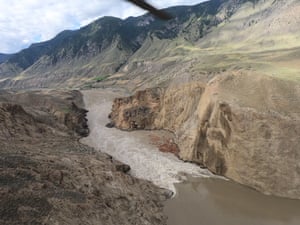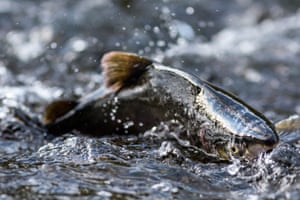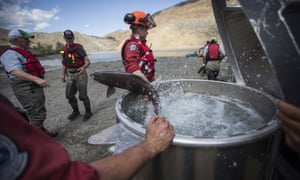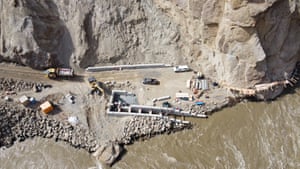When Gord Sterritt walked to the dusty edge of a cliff in western Canada last summer, he saw a disaster unfolding in the frothy waters below. In December 2018, a natural landslide had caused large chunks of rock to fall from the steep canyon walls that hem in the northern sections of British Columbia’s Fraser River.
The crashing boulders – 75,000 cubic metres of rock – created an impassable barrier. But because of the remote location, the damage wasn’t discovered until the following June: just as millions of wild Pacific salmon were beginning to spawn up the river.
“When I saw it, I realised what we were up against,” said Sterritt. “The magnitude was just … awe-inspiring. And not in a good way.”
The fallout from the rock slide could not have come at a worse time. Wild Pacific salmon populations had already suffered steep and seemingly irreversible declines over the years; biologists openly muse about a future without the fish.
Government work crews, aided by local First Nations, sprang into action, deploying nets, trucks, drones and dynamite in a frantic effort to help the salmon pass through the barrier.
Working through the dry summer heat at the site of the slide, known as Big Bar, as many as 100 people laboured from early morning until dusk, clearing debris and rescuing stranded – and incredibly weak – fish. Helicopters were brought in to airlift as many over the waterfall as possible.
Chinook, the hardiest type of salmon, made it through the frothy falls first, taking shelter in eddies to regain their strength before hurling their bodies into and over rocks. As crews cleared more space in the river, sockeye and pink salmon began clearing the barriers. In all, nearly 250,000 salmon successfully traversed the landslide area – with another 30,000 flown in by helicopter – a long way off the millions that normally make the journey.
Almost a year later, as the salmon return once more for their annual spawn, significant debris remains in the river.
“We knew from the start that this is a very difficult place to work and there’s a massive amount of material that has landed in this river,” Fisheries and Oceans Canada project leader Gwil Roberts said recently.

There are glimmers of hope in the protracted rescue mission: a pneumatic tube – called a Whooshh Passage Portal and nicknamed the “salmon cannon” – will soon be installed along the canyon walls to help move fish over the debris. A concrete fish ladder, constructed from hundreds of cement blocks, will also make the journey easier. And a convoy of trucks will be on standby to shuttle the fish over the barrier if things do not go as planned.
An exhausting journey
In some ways, the sustained effort by workers to save the fish, drawing on all possible resources, is dwarfed by the journey many salmon undergo at the end of their lives.
As their biological clock kicks in, salmon begin an exhausting journey from the Pacific coast to the rivers and streams of their birth – sometimes travelling more than 1,000km (600 miles). They are guided by magnetic fields and their keen sense of smell.
For a brief period, even the smallest streams are overwhelmed by tens of thousands of fish, transforming the tranquil bodies of water into a flurry of life.

“They’re splashing around, they’re chasing each other. It feels like the river is just pulsing with life,” said the Vancouver-based salmon researcher Vanessa Minke-Martin. “It’s a really magical thing to see.”
But the journey has a devastating impact on their bodies. From the moment they first enter fresh water, they stop eating and their bodies begin to decay and weaken. If they make it to a calm location in a stream, they reproduce and await their inevitable death within days.
Even reaching the site of the Big Bar landslide is a miracle: the fish need to travel more than 200 miles from the mouth of the Fraser River, running against the current the whole way. Some continue for another 400 miles to reach the streams where they were born.
Because of their unique life – born in fresh water, migrating to the ocean and living for years in the salty waters, only to return home to reproduce and die where they hatched – salmon have a deep integration with nearly everything they interact with. First Nations have long understood the importance of that interaction. Indigenous communities that thrived nearly always did so because of their proximity to coveted salmon rivers.
“We used to hear stories of people walking across the river on the backs of fish there were so many,” said Sterritt, of the legendary bounty, harvested and smoked for the winter or traded with other communities.

Bears and wolves prowling the banks of rivers feast on the flesh of spawning fish, discarding the carcasses for eagles to scavenge. “Even trees in the forest take nutrients from the decomposing carcasses,” said Minke-Martin, a reference to a study that found trees growing on the banks laden with nitrogen-rich salmon remains grow much larger than on streams with no salmon.
With ecosystems relying heavily on the presence of salmon each year, the collapse of populations has been devastating. Southern resident killer whales off the coast of British Columbia – which rely on an abundance of chinook – are teetering towards extinction. Last summer, emaciated grizzlies wandered aimlessly, searching for migrating salmon that were nowhere to be found. The starving bears only survived because of the generosity of local First Nations, who deposited hundreds of salmon on the banks of the inlet.
Half of Canada’s mighty chinook, many of which spawn in the Fraser River and its tributaries, are considered endangered. All other species of Pacific salmon are in precarious decline. By some estimates, in nearly 100 years, 75% of sockeye have been wiped out.

Last summer, 4.8m sockeye were projected to spawn in the Fraser. But this month, officials told parliament that 99% of the early Stuart sockeye run and 89% of early chinook salmon had been lost, largely because of the slide.
It was clear by winter that the mission to rescue the salmon in Fraser had not gone to plan. Many were in poor health from the prolonged fight against the falls, government biologists said, calling into question their ability to finish the long journey home.
Near Prince George, only a single female chinook returned. “She swam back and forth and eventually died all by herself,” Dustin Snyder of the Spruce City Wildlife Association, told CBC news in December.
A number of streams in the area had no salmon return – and for those that did, the numbers were small. “They were battering themselves and getting stressed,” said Roberts. “This year we have the plan in place to move the salmon to ensure they can get across the slide site and we are very hopeful we will have very, very low mortality.”
Rescue mission
The fish ladder and salmon cannon have brought much-needed hope to the operation this year. The terraced concrete ladder is being constructed to allow salmon to travel through channels of water that are flowing slower than the river – enabling them to bypass obstacles. Ladders are already a common sight at dams, which prevent salmon from naturally completing their spawning runs.
“Fish will sense the existence of flowing water coming down the ladder, move up the ladder, come around into a holding pen,” said Roberts. They will then be guided into the Whooshh Passage Portal – a series of six 150-metre pneumatic tubes running alongside the cliff face.
The fish will move 19 metres per second for 20 seconds. The Seattle-based company that produces the device, Whooshh Innovations, says the transported salmon will then be gently deposited back into the water, past the boulders in the river.
On the advice of the Yinka Dene Alliance, a coalition of six First Nations affected by the slide, the government has also bought itself time in the event none of the strategies work: a handful of eggs from the most vulnerable salmon runs – early stuart chinook – were sent to a hatchery, which Roberts says gives officials the opportunity of reviving the population if needed.

But significant rock debris remains in the river and costs paid to a private company tasked with removing boulders have continued to balloon, from an estimated US $12.3m (GBP9.7m) to nearly $38m.
While it initially appeared to be an isolated incident in a remote pocket of the province, the landslide has instead forced a reckoning about the trajectory of vulnerable salmon, raising the troubling prospect that the rescue mission – and any other efforts – might have been too little, too late.
“Losing wild salmon is going to affect everything. The bears and the eagles. It’s going to affect everything that people find amazing,” said Sterritt. “We’re not gonna see that any more. We’re not going to have those animal species – and our forests – flourishing.”
Find more age of extinction coverage here, and follow biodiversity reporters Phoebe Weston and Patrick Greenfield on Twitter for all the latest news and features